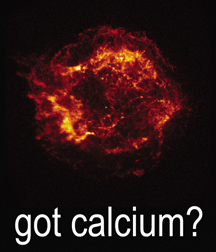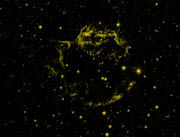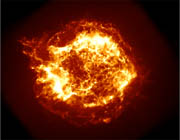Got Calcium?

Calcium comes from stars. In fact, all of the elements that make up your body and the planet Earth itself, other than hydrogen and helium, were made in stars or during during explosions of massive stars. Stars are like mighty chemical factories. They burn hydrogen and helium through a process of nuclear fusion, which produces a tremendous amount of heat energy. In addition to energy, the fusion process in massive stars (stars having more than 8 times the mass of our sun) results in carbon, nitrogen, iron and other atoms. As iron accumulates in the stellar core, the fusion process no longer produces heat energy. At this point in the life of a massive star, the core collapses and the star explodes, sending all those atoms racing into space. Some atoms bump into each other in the fury, fusing to create even heavier atoms such as gold, silver and uranium. These atoms spread across the galaxy over the course of billions of years. Cassiopeia A is a star that exploded about 320 years ago. No astronomer recorded the explosion at the time, but we can still see the remains of the explosion today in the form of a colorful supernova remnant. By measuring the motion of the gas in the remnant, astronomers deduce its age.
The Michigan-Dartmouth-Massachusetts Institute of Technology Observatory on Kitt Peak, Arizona, captured a beautiful image of Cassiopeia A in visible light (above, left). In an image accumulated over a million seconds, The Chandra X-ray Observatory, an earth-orbiting satellite, saw the hot X-ray-emitting gas from the explosion (above, middle). This gas is hotter than the surface of the sun. Chandra was also able to see the individual elements within the explosion. For example, researchers at NASA's Goddard Space Flight Center created an image showing only the element calcium (above, right).
For the classroom:How much calcium is in Cassiopeia A? Use the following information to find out:
For more information on supernovae and supernova remnants, see: |

 Except on Earth, the Milky Way galaxy doesn't contain any milk. But it sure does have a lot of calcium. There's enough calcium floating between the stars to fortify trillions upon trillions of gallons of milk.
Except on Earth, the Milky Way galaxy doesn't contain any milk. But it sure does have a lot of calcium. There's enough calcium floating between the stars to fortify trillions upon trillions of gallons of milk.


